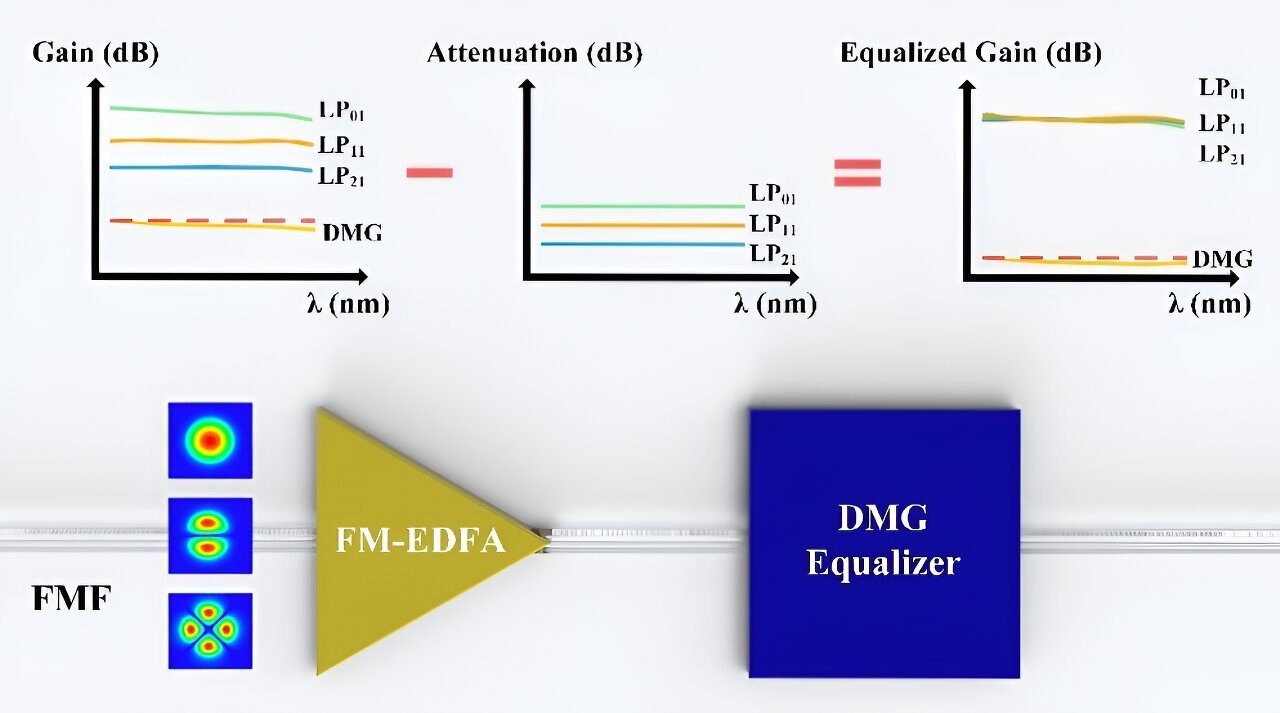by Key Laboratory of Photonic Technology for Integrated Sensing and Communication

Optical fiber, as a physical medium for information transmission, is the “highway” of modern economic and social development. However, with the continuous emergence of high-speed and high-capacity communication scenarios such as virtual reality, 5G, intelligent driving, and the Internet of Things (IoT), there is an upper limit to the communication capacity (traffic flow) of the traditional single-mode fiber-optic communication system (highway).
Mode Division Multiplexing (MDM) technology, which exponentially expands the capacity of communication systems by using multiple mutually orthogonal spatial modes within a few-mode fiber as independent transmission channels, has gained global research attention.
However, differential modal gain (DMG) in the few-mode erbium-doped fiber amplifier (FM-EDFA), due to the different overlapping integrals among the pump mode profile, the erbium doping, and the signal mode profile, limits both the capacity and the reach of MDM transmission.
In a new paper published in Light: Advanced Manufacturing, a team of scientists, led by Professor Yuwen Qin from Key Laboratory of Photonic Technology for Integrated Sensing and Communication, Ministry of Education of China, and co-workers have developed an innovative differential mode gain (DMG) equalization strategy via femtosecond laser micromachining induced refractive index (RI) tailoring.
Based on the precise and controllable RI tailoring, a specific attenuation spectrum can be applied to different guide mode groups according to their gain spectrum, leading to a successful DMG equalization. To verify the feasibility and advantages of the proposed DMG equalization strategy, they investigated a simple-structured and cost-effective FM-EDFA with uniform Erbium doping and fundamental mode core-pumping.
More interestingly, the proposed DMG equalization scheme works very well even when the guided mode group increases to higher orders. The reported method and technique open a new vision angle to the highly efficient and low-cost DMG equalization scheme in the MDM system.
These scientists summarize the device operation principle as follows, “Simulation results show that, when the pump power and the EDF length vary from 200 mW to 600 mW and 1 m to 7m, DMG within LP01, LP11, and LP21 mode groups varied from 4.8 dB to 16.2 dB occurs. By cascading the DMG equalizer with optimal values of length L and ∆n, the DMGmax and DMGave over the C-band can be reduced from 10 dB to 1.52 dB and 8.95 dB to 0.78 dB, respectively.
“A proof-of-concept experiment shows that the DMGmax is reduced from 2.09 dB to 0.46 dB, and the DMGave over the C-band is reduced from 1.64 dB to 0.26 dB. More importantly, the IL induced by the DMG equalization is less than 1.9 dB, indicating that 64% of the pumping power is efficiently utilized. Meanwhile, the proposed DMG equalizer has a maximum equalization range of 5.4 dB, which can satisfy the flexible application of current FM-EDFA.”
“Higher-order mode group DMG equalization could be anticipated with more complicated RI modification pattern and higher-resolution femtosecond laser micromachining technology, which is ideally desirable for future long-haul MDM transmission,” the scientists forecast.
More information:
Cong Zhang et al, Differential mode-gain equalization via femtosecond laser micromachining-induced refractive index tailoring, Light: Advanced Manufacturing (2024). DOI: 10.37188/lam.2024.014
Provided by
Key Laboratory of Photonic Technology for Integrated Sensing and Communication
Citation:
Scientists develop DMG equalization strategy via femtosecond laser micromachining induced refractive index tailoring (2024, August 28)
retrieved 28 August 2024
from https://phys.org/news/2024-08-scientists-dmg-equalization-strategy-femtosecond.html
This document is subject to copyright. Apart from any fair dealing for the purpose of private study or research, no
part may be reproduced without the written permission. The content is provided for information purposes only.
